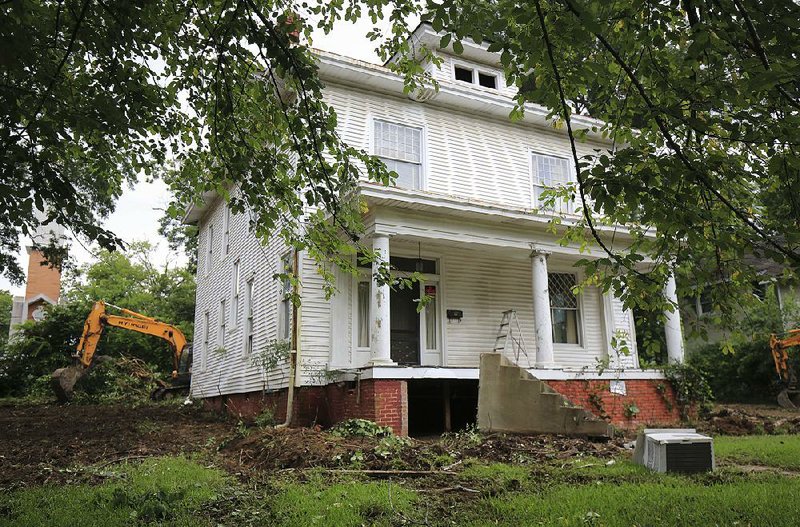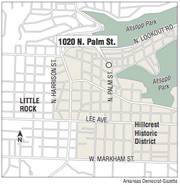The razing of a 110-year-old home in the Hillcrest neighborhood of Little Rock has renewed efforts to establish a local-ordinance historic district for the area and prevent the loss of similar homes that proponents say help give the neighborhood its funky character.
Workers on Friday began tearing down the two-story American Foursquare-style home at 1020 N. Palm St. called the Branch house. It was built in 1907 and is, or was, one of the oldest homes in Hillcrest, according to the Arkansas Historic Preservation Program.
The home is the latest to be demolished to make way for more modern buildings, a trend that has left some residents alarmed.
"There's nothing that can be done," said Kim Abbott, who lives next door to the home being razed. "It's frustrating."
Hillcrest covers more than 600 acres generally bounded by North Woodrow Street on the east, N̶o̶r̶t̶h̶ ̶J̶a̶c̶k̶s̶o̶n̶ ̶S̶t̶r̶e̶e̶t̶ North Harrison Street* on the west, West Markham Street on the south and North Lookout Road on the north. Once part of the city of Pulaski Heights, the major development of Hillcrest occurred between 1900 and 1940. It is considered Little Rock's first suburb.
The eclectic mix of historic homes ranging from quaint bungalows on up are within walking distance to schools, churches, stores and restaurants.
"You're not going to find any of those things in a new neighborhood," said Antoinette Johnson, a Hillcrest resident who is a historic preservation consultant and a historic interior designer.
And it is precisely why David and Jamie Shipley said they purchased the home earlier this month for $320,000.
"Hillcrest is a great neighborhood," David Shipley said. "We like the eccentric vibe."
In fact, they used to live in a Hillcrest bungalow, and restored it. They sold it because Jamie Shipley said it was too small for the family they wanted to start. They now have two young sons, one of whom attends a neighborhood school. The family attends a church in Hillcrest.
"We're there all the time," Jamie Shipley said. "We want to move back."
But the home they chose was beyond restoration, they say. It has extensive termite and water damage and issues with the foundation.
"We restored a home," Jamie Shipley said. "This is not a restorable home."
Homes like theirs "needed to be preserved all along," she said. "When they have fallen into such a state of disrepair is not the time to get up in arms about it."
Jamie Shipley dismissed the tax credits available for historic homes. "There's not a tax credit big enough to restore this."
Both she and her husband said they want to build a home that will fit in the neighborhood.
"We're going to make it a nice home, be nice neighbors and contribute to the neighborhood," Jamie Shipley said.
The Palm Street home is considered a contributing resource for the Hillcrest Historic District -- a building that adds to the significance of the district and supports its listing on the National Register of Historic Places.
The listing of the district on the national register is only a designation and offers no protection to historic structures within it. The neighborhood is a historic overlay district, which means new construction must be done in keeping with the tenor of surrounding structures. The overlay district also limits setbacks.
The designation as a historic overlay district doesn't prevent demolishing old structures, but many residents who supported the designation believed the limitations would dissuade homeowners from doing that.
"The overlay district is not doing what we thought it would do," Johnson said.
She and other residents convened a meeting with city planners and state and local historic preservation officials to discuss what options are available to prevent further loss of historic homes in the neighborhood.
The likely answer is a local-ordinance historic district. Little Rock already has one: the MacArthur Park Historic District in the downtown area.
Efforts to designate Hillcrest as a historic district by the city Board of Directors have failed in the past. The designation can prevent demolishing old homes, but it also adds regulations to specify what homeowners can do to their structures.
Johnson said the effort is in its early stages, but one thought is to limit the area covered by the local-ordinance historic district, which would be a smaller part of the overall neighborhood.
"Our main goal is to stop the demolition," she said.
Patricia Blick, executive director of the Quapaw Quarter Association, a local historic preservation group, said she is saddened by the razing of the historic house in Hillcrest, but said some good may come of its loss.
"It is a catastrophic loss, the loss of an important building, the loss of a historic building," she said. "Unfortunately, we're losing the building, but we're also galvanizing support that might protect other historic structures."
Business on 06/24/2017
*CORRECTION: The western boundary of the Hillcrest National Historic District is North Harrison Street. A previous version of this article incorrectly described the western boundary.

